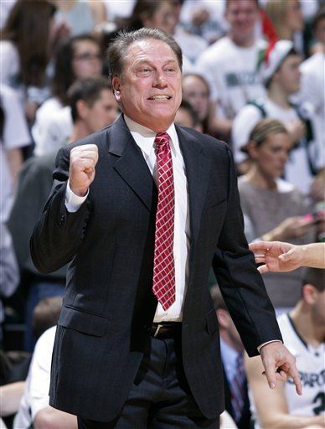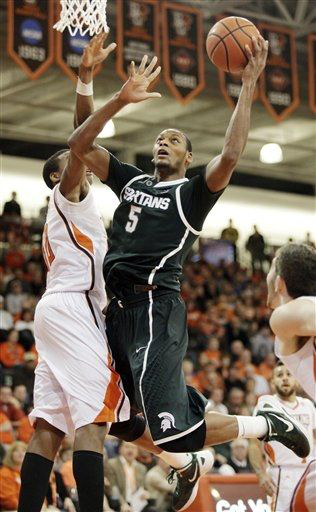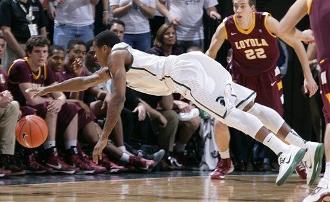Breslin Center | East Lansing, MI | Tip: 1 P.M. CT | TV: ESPN2 LRT Consecutive Game #232 The Texas Longhorns square off with Michigan State this afternoon in East Lansing, wrapping up one of the toughest weeks of the season, both on and off the court. On Wednesday night, Texas pulled off its biggest win of the season, knocking off a ranked North Carolina squad. As the final minutes of the victory ticked away, a Yahoo! report quickly spread through the sports world, breaking the news of a season-long suspension for sophomore point guard Myck Kabongo. As it turns out, the suspension had been handed down five days prior, on December 14th, and the Texas program was already in the process of appealing the decision. Last night, after the team had already landed in Michigan without their point guard, that suspension was reduced to 23 games. With 11 games having already been served, Kabongo will be available for the final eight regular season games and post-season play.
Tom Izzo will challenge for another Big 10 title With all of the off-court distractions, the Longhorns still had to prepare for a very tough test in the form of another talented Spartan team. Tom Izzo’s bunch has not lost to a non-conference opponent at home since Texas stormed out of the Breslin Center with a win in December of 2010. The upperclassmen on the Michigan State roster certainly remember that game, and will be looking for some revenge this afternoon. By the numbers As always, Izzo’s team plays nasty defense and is a handful on the glass. Michigan State’s adjusted defensive efficiency is tenth-best in the country according to Ken Pomeroy, allowing opponents just 0.863 points per possession. With the Texas defense ranked fifth in the same metric, fans should be treated to a scrappy battle with a lot of missed shots. On the glass, the Spartans are in the upper echelon on both ends of the court. They reclaim 37.9% of their own missed shots, ranking them 41st in the country. On defense, they limit opponents to just 27.5% of their offensive rebounding opportunities, a mark that is ranked 36th nationally. With that prowess on the offensive glass and a pair of imposing players scoring in the paint, the Spartans have a pretty efficient offense this season. Pomeroy’s adjusted offensive efficiency numbers give the Spartans 1.077 points per possession, which ranks them in the Top 50. Michigan State does it nearly all from inside, with only 20.5% of their scoring coming from behind the arc. Like Texas, the biggest weakness for Michigan State is turnovers. The Spartans end 23% of their possessions with miscues, while the Horns cough it up on 24.4% of their own. If the tough defenses weren’t already going to make it hard to score today, the offenses would still do their part with unforced errors. Meet the Spartans The man at the point is junior Keith Appling (No. 11), who is a converted shooting guard. He’s tops on the team with 15 points a game, and his 11.1% defensive rebounding rate is outstanding for a guard.
Keith Appling runs the show for Michigan State The Spartans run a ton of ball screens for their point guard, and he takes full advantage. Even though he doesn’t take a ton of threes, Appling can knock it down when opponents go under the screen. When he gets his man on his hip, Appling immediately drives it to the rack and can creatively finish through contact. At times, he’s too aggressive, as he’s picked up quite a few charging fouls while driving the lane. With Appling at the point, freshman Gary Harris (No. 14) is at his natural position of shooting guard, and it’s allowed him to play major minutes and make a big impact in his short collegiate career. Harris is second on the team with 12.7 points per game and is winning the coach’s favor with good perimeter defense. Like Appling, Harris is a constant recipient of perimeter ballscreens, but his repertoire is even more robust than Appling’s. He was a running back in high school, so he doesn’t shy away from contact, and loves to score through fouls at the rim. When the defense steps in to draw charges, Harris has a nice floater and a good midrange jumper that he can pull up to drain. He’s also knocking down just over 34% of his three-point looks, hitting about one per game. Tom Izzo has lamented the lack of a shooter on his interior-oriented team, and it’s clear that Harris is one of the best options to step into that role. He has a good shot and can get hot in a hurry, but has yet to consistently put it together. He knocked down 5-of-10 in his last game against Bowling Green, but was just 1-for-7 against Tuskegee three days prior. If he can build on his latest performance with another good game against Texas, Harris could be hitting his stride just in time for Big 10 play on December 31st. Sophomore wing Branden Dawson (No. 22) is one of the team’s most exciting players, but an ACL tear in March has slowed down his development a little bit. Dawson was starting to break out as an offensive threat at the end of his freshman year, but suffered that devastating injury in the final regular season game. He went through an incredibly rapid rehab, returning to action in just seven months. Although Dawson is missing a little bit of his explosiveness and some of the lateral quickness that made him a tough defender, he’s still been impressive this season. Dawson is built like a tank, and when he slashes to the rim he is very tough to stop. He has good body control and knows how to protect the ball so that he can use his strength to finish through contact. He’s also a good post-up option, especially when matched up against other wing players of similar size. Dawson rebounds extremely well from the wings and is ranked in the Top 250 for offensive rebounding percentage. If he can start to consistently knock down the jumper, the sophomore will be an all-around stud. Coach Izzo has recently favored a smaller, four-guard look with freshman Denzel Valentine (No. 45) joining the starting lineup. At 6’5″, he brings some length to the perimeter and has the handles to slash from the wings. Valentine also has excellent court vision and makes great passes once he gets the defense reacting. Unfortunately, he’s also had a terrible time with turnovers this season, so he’s not getting the opportunity to really show off those other skills. Valentine has coughed it up 27 times against just 32 assists, giving him an ugly 30.9% individual turnover rate. The man in the middle of the new lineup is 6’9″ senior Derrick Nix (No. 25). The big man has shed a lot of weight throughout his collegiate career, but in years past has been known to put it back on during the summer. This year, he showed up in the best shape yet, and his post game looks so much smoother as a result. Unfortunately, that lack of a shooter on the Michigan State roster has allowed opponents to sag into the lane and constantly double the big man. At times, the Spartans have been lax in hurrying to his aid, abandoning him against the pressure. When he has teammates available for the kickout, Nix does a great job of tossing it out and immediately reposting. The rest of the Spartans just need to be more alert so they can help out the big man instead of stranding him in the post.
Adreian Payne is thriving in his new role as sixth man Nix is also dominant on the glass, grabbing more than 10% of his offensive rebounding opportunities and more than 22% of his chances on the defensive end. His 7.5 boards per game are tied for tops on the team. Adreian Payne (No. 5) is the man tied with Nix atop the team rebounding rankings, despite volunteering to take on a sixth-man role early in the year. Payne was struggling with foul trouble during the first few weeks of the season, limiting his minutes and effectiveness. Since coming off the bench, he has avoided the quick fouls and increased his playing time. Payne is a great defensive presence in the lane, with quick hops to block shots. At 6’10”, he can clean up shots from the help side and closes out numerous possessions with authoritative defensive boards. Payne is also a very good passer, a trait that makes the Spartans very tough to stop when he and Nix share the floor at the same time. He also can knock down shots out to about 17 feet, allowing him to pull opposing bigs out of the lane to clear space. It also makes him a consistent threat to pick and pop on the numerous ball screens that Michigan State sets. The Spartans don’t have much depth in the post, with Alex Gauna (No. 2) providing the only other option. He’s averaging just 7.2 minutes per game, but he brings the same floor-stretching abilities to the court as Payne. Gauna is not nearly the rebounder that Nix and Payne are, but he’s still able to post up and is rather slippery for a guy his size. Coach Izzo thinks he’s going to trim his rotation to nine guys at some point this season, meaning one of his three guard reserves will likely be the odd man out. Travis Trice (No. 20) is the backup point guard, but he’s missed some time this year due to concussion-symptoms suffered after taking a shot to the nose in the season opener against Connecticut. Sophomore Brendan Kearney (No. 3) is averaging nearly 18 minutes a game and brings good length and perimeter defense with his 6’5″ frame. Fellow sophomore Russell Byrd (No. 0) is struggling with his shot as he comes back from foot injuries, sinking just 19.4% of his 31 three-point attempts. Keys to the game 1) Avoid settling for bad shots – Michigan State’s defense can be suffocating at times, and their presence on the defensive glass is downright dominant. The Spartans have allowed opponents to post effective field goal percentages greater than 47% in only four games — losses to UConn and Miami, and three-point victories over Kansas and Louisiana-Lafayette. In each of those games, the Spartans still held their opponents to offensive rebounding marks below 25%. Even though Texas did a great job reclaiming missed shots against North Carolina on Wednesday, it’s doubtful they can consistently find much success today against the Spartans. That makes every shot more important, and Michigan State is great at forcing their opponents to take bad ones. The Longhorns have struggled this season to shoot the basketball, even when they work to get great looks. They will have to be patient today and actually capitalize when they are able to get good opportunities.
The Spartans have struggled with turnovers this year 2) Capitalize on Spartan mistakes – The Spartans have had trouble hanging on to the basketball all season long, posting turnover marks north of 25% on five different occasions. With Michigan State’s defense being so difficult to crack, Texas needs to take advantage of these miscues and score some points before the Spartans can get entrenched in their half-court D. It’s also important to note that many of Michigan State’s turnovers are live-ball ones, meaning that the Longhorns should have ample opportunity for runouts and fast break buckets. If Texas misses out on these opportunities, like they did in a crushing loss to UCLA, there will be no chance of an upset this afternoon. 3) Limit turnovers – This has been a staple in the Keys to the Game, and despite recent improvements by the Horns, it remains in today’s preview. Points will be very hard to come by this afternoon, and turnovers will only serve as a mistake that hurts on both ends of the court. Texas cannot afford to give up easy points to Michigan State, and the Horns cannot waste their own offensive possessions. The Longhorns have posted turnover percentages of 15.5%, 17.4%, and 16.1% in their last three games. A performance similar to that will keep them in position to challenge for an upset today. Conversely, careless mistakes like those seen in the Maui Invitational and against Georgetown will quickly squash any hopes Texas has of pulling off a shocking road win. |












